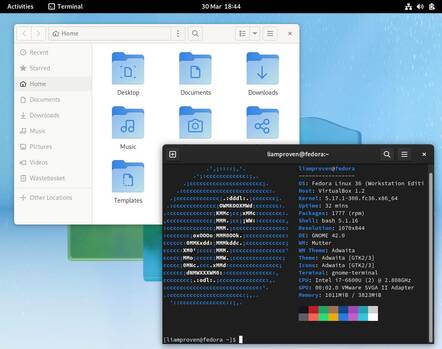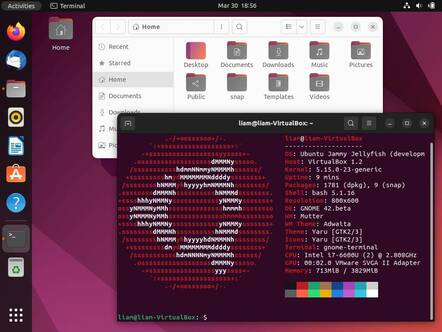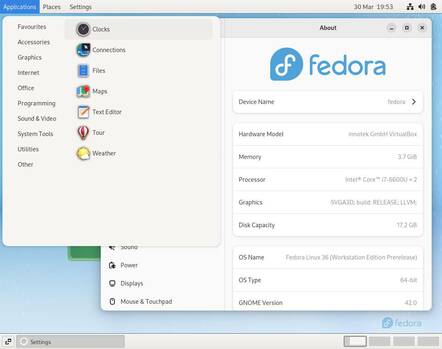This article is more than 1 year old
Next versions of both Fedora and Ubuntu head into beta
GNOME 42 and some other small changes for both... though we still miss Unity
Late April should see the release of the 36th versions of two of the biggest Linux distros: Fedora 36 and Ubuntu 22.04.
Red Hat just announced the official beta of Fedora 36, whereas Ubuntu 22.04 should hit beta freeze on March 31.
These are both quite mature products now. Both organizations generally put out new versions twice a year, as does the GNOME Project. Fedora Core 1 appeared a year before the first release of Ubuntu, 4.10, but Fedora's release cycle is less regular than Ubuntu's: some years have seen one release of Fedora, and some three. Both versions default to using GNOME 42 on top of the Wayland display server, so they have quite similar desktops.
The final release of Fedora is planned for April 19, 2022, and if there are problems, it may slip to April 26. Ubuntu 22.04 is scheduled in between, for April 21.
We gave both a quick test drive in identically configured VirtualBox VMs, with two CPUs, 16GB drives, and with 3D acceleration enabled.
Fedora 36
Fedora 36 doesn't have a cool nickname – the project dropped those after version 20. We allowed it to auto-partition the disk, and ended up with a 1GB ext4 boot partition, and the rest of the disk formatted with Btrfs. There was no dedicated swap partition or file: it chose to use zram by default.
This release uses kernel 5.17, which is the current mainline version. If you want to know the specific versions of all the sub-components, the project has an official list of changes.
After installation, running a software update offered 491 new packages, so it's still in very active development.
A nice touch is that Fedora detected the VirtualBox VMSVGA display and the desktop automatically resized with the VM window – under both Wayland and X.org. Also, the GNOME Classic session type is pre-installed if GNOME Shell isn't your thing.
If you prefer KDE, that too is the latest version 5.24.
Fedora comes with an assortment of mostly GNOME apps, including the Boxes hypervisor, Photos, Videos, the new Text Editor, and a guided tour – but the classic GNOME Terminal rather than GNOME 42's new Console. In this version, both the "Dash" app-switcher and the virtual-desktops switcher are horizontal.
Ubuntu 22.04
The 36th release of Ubuntu will be known as "Jammy Jellyfish." Its alphabetic codenames have looped around now: last time was "Jaunty Jackalope," version 9.04.
We gave a short spin to the last daily build before the date of the beta freeze. An immediately noticeable difference is that the distro's logo has changed.
Ubuntu put the word "VirtualBox" into its auto-selected machine name, but window-size integration was not working by default, under either display server. We had to install the guest additions to get it working on X.org, but it still didn't work using Wayland.
However, Ubuntu did geolocate the test VM's IP address and automatically set the system locale to Czech. That isn't actually what this Anglophone vulture wanted, but it's probably handy for most people.
After installation, there were 290 updates outstanding, so this too is just a preview of an unfinished release.
Ubuntu customizes the GNOME experience more than Fedora. As usual, there's the Ubuntu dock, a fork of Dash to Dock, plus extensions to provide desktop icons and Ubuntu's AppIndicators. As a result, the GNOME dock is still vertical, which we feel makes more efficient use of a widescreen display.
Another less welcome customization was a banner ad at the top of the desktop offering the company's new "Ubuntu Pro" service. The Reg asked the company for clarification about this, but we haven't got any yet. In the meantime, we suspect it's a rebrand of the Ubuntu Advantage paid support offering.
The new version uses kernel version 5.15, the current long-term support version. As we predicted, this is an appropriate choice, as 22.04 will stick around for several years longer than Fedora 36.
Allowing the distro to automatically partition our hard disk, we ended up with a 1MB BIOS boot partition and a half-gigabyte UEFI ESP volume, even though our VM doesn't have UEFI. This is a known bug that has been left unfixed for a couple of years now, and will prove limiting if you're dual-booting: MBR partitioning only allows four primary partitions, and Windows tends to hog several.
A small mercy is that, as of 17.04, Ubuntu uses a swapfile rather than a dedicated partition – although you can add a partition if you want, such as to put it on a different drive. The rest of the disk is formatted with ext4. At this stage, ZFS remains an experimental feature.
Ubuntu has chosen to stick with the classic GEdit text editor and Terminal app, rather than GNOME 42's new replacements. It uses Shotwell for photo management, and throws in a few games and the Transmission Bittorrent client. Ubuntu has a more relaxed policy to proprietary tools than Fedora, and its driver detection and installation tool will help some. Ubuntu also has its own Software Store app because it uses Snaps rather than Fedora's Flatpak, and notably Firefox comes packaged as a Snap.
- GNOME 42's inconsistent themes are causing drama
- GNOME Project retires OpenGL rendering library Clutter
- As System76 starts work on its own Linux desktop world, GNOME guy opens blog, engages flame mode
- Zlib crash-an-app bug finally squashed, 17 years later
Despite the issues around themes in GNOME 42, Ubuntu has themed it anyway, with an updated version of its purple-and-orange-hued Yaru.
Rounding corners up
Neither of these releases is a huge change – which in Ubuntu's case is what you want in a long-term support release. We prefer Ubuntu's modestly tweaked GNOME to Fedora's vanilla version. Then again, Fedora builds in the GNOME Classic desktop. On the whole, though, at The Reg FOSS desk we still miss Unity.
Fedora may use Btrfs now, but it lacks openSUSE's handy automatic snapshots. This means that you don't get one of the big benefits of the filesystem unless you configure it yourself.
Both are good, solid, mature desktop distros, and we suspect neither has enough of an edge to tempt across those who prefer the other. ®



